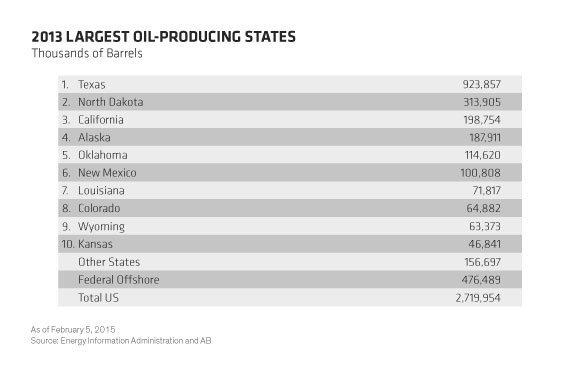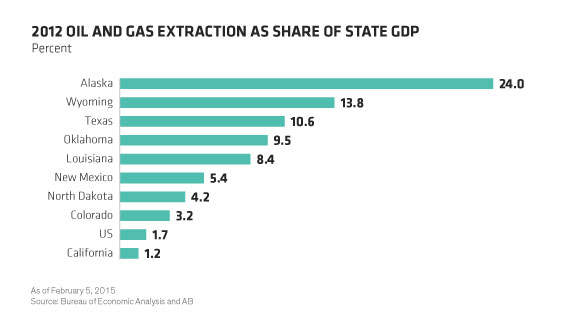Crude oil prices have fallen sharply since last summer, a bright spot for American consumers. Major oil-producing states aren’t as happy, because the loss in tax revenue is impacting budgets and economies. Some states will face real hardship; others will emerge relatively unscathed.
Of the 10 largest oil-producing states in the US (Display), Alaska’s state budget will be most severely affected, with New Mexico and Wyoming next in line. The rest of the top ten receive less than five percent of their revenues from oil taxes. In terms of the overall economic impact, North Dakota will see the largest hit; we expect the price crash to drive the state into recession in 2015. In California, Colorado and Kansas, diverse economies should limit the impact. The other largest producers will face a moderate economic shock.

Here’s our more specific take on a few of the top oil producers:
Texas will be affected—but not as much as you’d think.
Texas is the largest oil producer in the US, but declines in oil revenues should have only a modest negative effect on its budget. Two reasons: Texas has strong reserve funds, and revenues from other key sectors, such as healthcare and high tech, should help offset the loss.
Texas legislators are also smart about how they allocate oil money; they don’t rely on it for the basics. Texas oil and gas producers paid $3.6 billion in taxes in 2013 (4.5% of state revenues), but most of that figure was dedicated to emergency savings and highway funds.
As for budget reserves, Texas has amassed the highest balance in its history, giving it unprecedented flexibility to weather the oil price challenge. The rainy-day fund currently has a balance of more than $8 billion—about 9% of total spending.
But Texas will see an economic impact.
The energy sector fueled Texas’ recent rapid economic growth, so an extended oil price decline will likely reduce the rate of expansion. Real gross domestic product (GDP) has averaged 4.4% annualized growth since 2010, more than double the 2% national average. Growth has been especially strong over the past year.
A slight budget pinch for North Dakota, but a big economic hit.
North Dakota is the nation’s second-biggest oil producer, and it pulls in significant cash from production and extraction taxes. But its budgetary exposure to the downturn is limited because state regulations prevent it from depending too much on oil money. Total oil tax collections to the state’s general fund are capped at $300 million per two-year period (about 5% of the general fund); anything over that amount is transferred to other funds. Right now the state’s large reserve also means it can absorb oil’s low prices. But even so, North Dakota is likely to face a recession. Its record growth since 2006 has come from rapid expansion in the energy and agriculture sectors—an expansion which can’t continue.
The surprise: California won’t be impacted.
California’s massive economy is exceptionally diverse, and the share of jobs and GDP provided by oil and gas is below the national average. Oil tax revenues are negligible for the state’s budget. The state doesn’t assess a severance tax on the removal of nonrenewable resources, although oil and gas companies pay state corporate income taxes and local government property taxes.
No shocker: Alaska will face a major budget and economic jolt.
Oil companies pay significant taxes in Alaska, and those revenues provide almost 90% of unrestricted general-fund revenues. So, the price collapse has opened a huge gap in the state’s budget. The state’s fiscal year 2015 operating budget is just under $6 billion, and officials now estimate a $3.4 billion deficit. The governor has already indicated state plans to announce layoffs.
On the plus side, Alaska has massive budget reserves—currently about 20 times the size of the budget gap. But the state’s credit rating is still likely to be downgraded if oil prices stay below $75 a barrel. Because the state owns the North Slope oil fields, Alaska’s rating depends on oil prices.
Alaska’s economy also depends heavily on the oil and gas sector, which accounts for a massive 24% of the state’s GDP (Display). The sector has recently grown significantly in Alaska: from 8,900 jobs in 2002 to 15,200 in 2014 (4% of total jobs) due to increased exploration activity. That trend will reverse.

Oklahoma will be okay.
Severance tax revenues make up a modest 4% of total general-fund revenues, so the state’s budget will take only a small hit. However, we’re concerned about local governments whose economies are concentrated in oil.
Summing it up: most states can handle the price drop.
States have emerged from the recent recession in fairly strong shape, having done the hard work of cutting expenses and rebuilding reserves. The drop in oil prices presents some with a second challenge. However, most policymakers learned from the past and diversified their economies away from a dependence on oil and gas revenue. Only North Dakota and Alaska should feel significant economic pain from cheap oil.
The views expressed herein do not constitute research, investment advice or trade recommendations and do not necessarily represent the views of all AB portfolio-management teams.